11 Remedies For Impetigo, Causes, Signs, & How To Treat It
From natural remedies to lifestyle changes, there are many ways to treat this skin infection.

Image: Shutterstock
Impetigo is an extremely contagious skin infection. Children are at high risk of contracting impetigo. Therefore, parents often use many home remedies for impetigo to protect their kids. This bacterial infection is responsible for about 10% of skin issues in children (1).
A study conducted on 225,979 children found the overall incident rate of non-bullous impetigo (NBI) was 9.5 per 1000 persons a year, with children aged 1-4 having the highest incidence rate at 13.2 per 1000 persons a year. Approximately 50% of patients with impetigo may experience recurring episodes within 12 months.
Symptoms of impetigo include small, red, and inflamed rashes all over the child’s torso or red sores around the nose and mouth. It would be best to treat the infection immediately before the sores leave scars. This article discusses how to soothe impetigo sores and promote healing with home remedies, along with some prevention tips. Keep reading to learn more.
In This Article
What Is Impetigo?
Impetigo is a skin infection that is highly contagious and very common. It is caused by the Streptococcus pyogenes or Staphylococcus aureus bacteria and can be easily treated with topical creams and medication. Impetigo usually affects infants and children and occurs in the form of red sores. These sores can burst and form honey-colored crusts.
The classic signs and symptoms associated with impetigo are discussed below.
Key Takeaways
- Impetigo is a highly contagious skin infection that causes tiny, red, and inflammatory rashes all over a child’s body, as well as red sores around the nose and mouth.
- Staphylococcus aureus (S. aureus) or Streptococcus pyogenes (S. pyogenes) cause this bacterial infection.
- Natural remedies such as tea tree oil, oregano oil, garlic, coconut oil, etc., can help heal this skin infection.
Signs And Symptoms
The common symptoms of impetigo are red sores that rupture, ooze, and finally dry to form a yellowish-brown crust. The size of these sores may range from a dime to a quarter. Such sores usually appear on the face, around the nose and mouth, and on the hands and feet of the infected person.
Pamela, a mommy blogger, noticed her 11-year-old son developed a painful and itchy rash on his chin. The rash eventually worsened, oozed yellow pus, and formed scabs. She recalls, “OH how childhood memories started flooding back to me. I knew exactly what it was. I used to get it when I was a child (about his age) every summer… It was Impetigo (i)!”
Bullous impetigo is a lesser-known form of impetigo. It is characterized by larger blisters and occurs on the trunk of the affected child.
Ecthyma is another severe type of impetigo, which penetrates deeper into the skin. It causes painful pus- or fluid-filled sores, which develop into deeper ulcers. These sores are much darker and thicker than ordinary impetigo.
Knowing the signs and symptoms of impetigo is important since it helps medical professionals make an accurate diagnosis and choose the best course of therapy. Scroll down to know more.
Diagnosis Of Impetigo
To diagnose impetigo, medical professionals usually begin with a physical examination, evaluating the skin’s characteristic blisters and ulcers. They will search for symptoms like redness, swelling, and crusts that resemble honey. To determine the precise bacteria causing the illness, a sample of the fluid from the sores may occasionally be taken and submitted to a lab for analysis. This helps in choosing the best course of action, particularly in cases with severe or persistent impetigo.
Let us now look at the leading triggers of this contagious infection.
What Causes Impetigo?
Impetigo is a bacterial infection triggered by Staphylococcus aureus (S. aureus) or Streptococcus pyogenes (S. pyogenes). S. aureus is present on the skin, while S. pyogenes is present in the mouth flora. These bacteria cause infections when there is a cut or wound.
The infection usually begins in two ways:
- Primary Impetigo – The bacteria initiate an infection on healthy skin without an entry site.
- Secondary Impetigo – The bacteria invades the skin due to another skin condition that has disrupted the skin’s barrier (e.g., scabiesi An itchy, contagious (spreads easily through physical contact) skin rash caused by tiny mites that burrow into the skin. or eczemai A long-term allergic, inflammatory skin condition that causes itchy, swollen, and cracked skin. ).
Adults usually develop impetigo due to a skin injury from another skin condition like dermatitis, which causes skin inflammation.
Children, on the other hand, are infected following a cut, scrape, or insect bite. They can also be infected without any damage to the skin when they are exposed to the infection directly or indirectly.
Factors that can increase the risk of developing impetigo are discussed right below.
Risk Factors
Certain factors can increase your risk of developing impetigo. They are:
- Age – It is common in children aged between 2 and 5.
- Crowded Environment – Impetigo can easily be contracted in crowded settings like child care or school.
- Warm and humid weather
- Sports, such as football or wrestling, which may involve direct contact with an infected person or utensil
- Injured skin
- Close dealing with an infected person
- Sharing utensils with an infected person
 Did You Know?
Did You Know?Herpes, lice, burn trauma, and insect bites can also trigger the development of impetigo (20).
Although impetigo is highly contagious, it can be cleared rather easily. Your doctor may prescribe topical and/or oral antibioticsi Medications that destroy the growth of bacteria and are used to treat certain types of bacterial infections. to deal with the infection.
However, if you are looking for natural alternatives to manage impetigo and speed up recovery, we have your back. Discussed below are the best home remedies for skin infections.
11 Natural Remedies To Treat Impetigo
Combining medical treatment with natural remedies may help manage impetigo symptoms. Consider the following natural options:
1. Essential Oils
(i) Tea Tree Oil
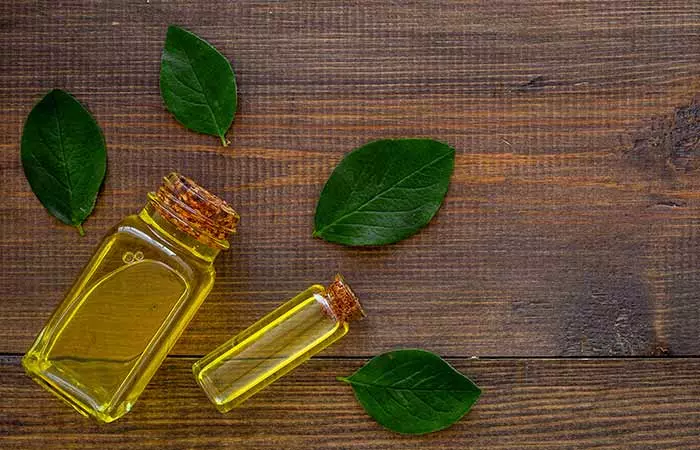
You Will Need Need
- 3-4 drops of tea tree oil
- 1 cup of water
- Cotton pads or balls
What You Have To Do
- Add three to four drops of tea tree oil to a cup of water.
- Mix well and dip a cotton ball into the solution.
- Gently swipe the infected area with the soaked cotton.
- Discard the used cotton.
How Often You Should Do This
You may do this 1-2 times daily.
Why This Works
Tea tree oil is antibacterial and can help in fighting staphylococci infections. Its anti-inflammatory properties can also help to alleviate itching and heal the sores (2).
(ii) Oregano Oil
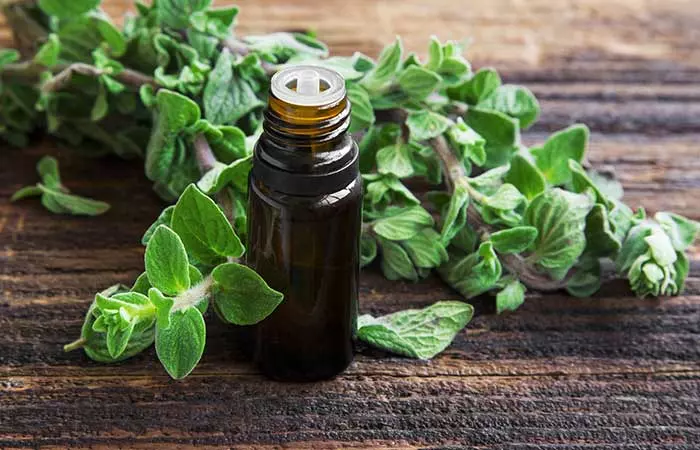
You Will Ne ed
- 3-4 drops of oregano oil
- 1 cup of water
- Cotton balls
What You Have To Do
- Add three to four drops of oregano oil to a cup of water.
- Mix well and soak a cotton ball in it.
- Apply the solution gently to the affected skin.
- Discard the used cotton.
- Leave it on until it dries.
How Often You Should Do This
You can do this 1-2 times daily.
Why This Works
The antibacterial activities of oregano oil can weaken the biofilm formation of Staphylococcus bacteria, thereby helping in the treatment of impetigo. A study published in the Journal of Medical Microbiology investigated the effects of oregano essential oil, carvacrol, and thymol on Staphylococcus aureus and Staphylococcus epidermidis biofilms. The results showed that these compounds inhibited biofilm formation at concentrations ranging from 0.031% to 0.500% (v/v) and eradicated existing biofilms at slightly higher concentrations. The subinhibitory doses of these compounds reduced biofilm formation on polystyrene surfaces, highlighting their potential as antibacterial agents against biofilm-related infections. Whereas, the concentrations needed to disrupt biofilms were two to four times higher than those required to inhibit free-floating bacterial growth (3).
Caution: Do not use essential oils topically on children as it may lead to skin irritations like dermatitis.
 Quick Tip
Quick Tip2. Garlic
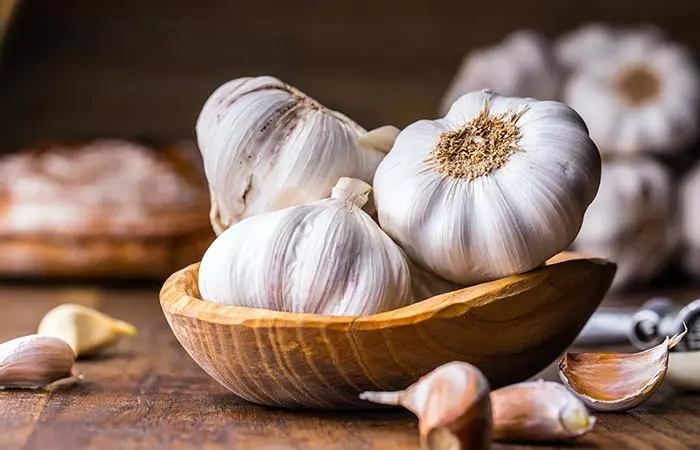
You Will Need
2-3 sliced garlic cloves
What You Have To Do
- Peel the garlic cloves.
- Chop the cloves into small pieces and place them on the sores.
- Take them off after 20-30 minutes and rinse with water.
- You can also add garlic to your diet for additional health benefits.
How Often You Should Do This
You can do this once daily.
Why This Works
Garlic has antimicrobial, immunomodulatory, and anti-inflammatory properties. A study published in the Journal of Natural Science, Biology, and Medicine examined the antibacterial effects of garlic extract against streptomycin-resistant Staphylococcus aureus and Escherichia coli. Researchers tested the extract alone and in combination with streptomycin, using an agar-well-diffusion assay to measure the zones of inhibition. The results showed that garlic extract had significant antibacterial activity and enhanced the effectiveness of streptomycin against resistant strains. Statistical analysis confirmed that the combination treatment was more effective than streptomycin alone, suggesting that garlic extract may help combat antibiotic-resistant bacteria (4). These properties can help in treating impetigo and accelerating recovery.
3. Coconut Oil
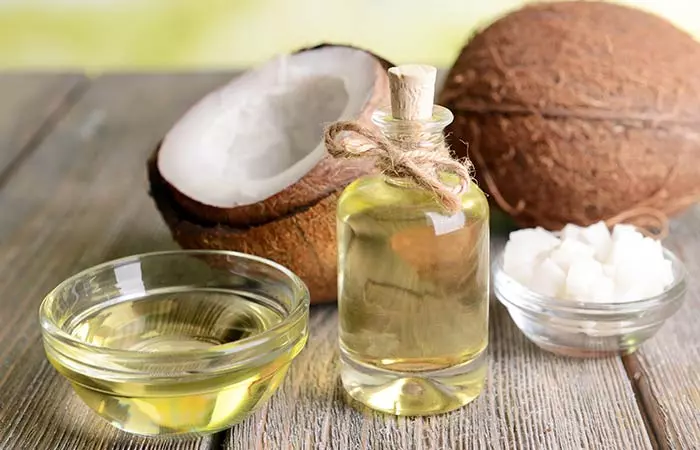
You Will Need
- 1 tablespoon of cold-pressed coconut oil
- Cotton swabs
What You Have To Do
- Take a tablespoon of coconut oil in a small bowl.
- Dip a cotton swab in it and apply it to the affected skin.
- Discard the used swab.
- Leave the oil on for 30 minutes to an hour.
- Rinse it off with water.
How Often You Should Do This
You can do this once daily.
Why This Works
Coconut oil possesses both anti-inflammatory and analgesic properties that can help in reducing the inflammation and pain in the affected areas. A study published in Pharmaceutical Biology explored the anti-inflammatory, analgesic, and antipyretic properties of virgin coconut oil (VCO). Researchers tested VCO in various animal models and found that it moderately reduced inflammation in both acute and chronic conditions, including ear and paw edema. It also exhibited pain-relieving effects by decreasing the writhing response in mice and showed fever-reducing properties in yeast-induced hyperthermia models. These findings suggest that VCO may have natural therapeutic potential for managing inflammation, pain, and fever (6).
4. Apple Cider Vinegar
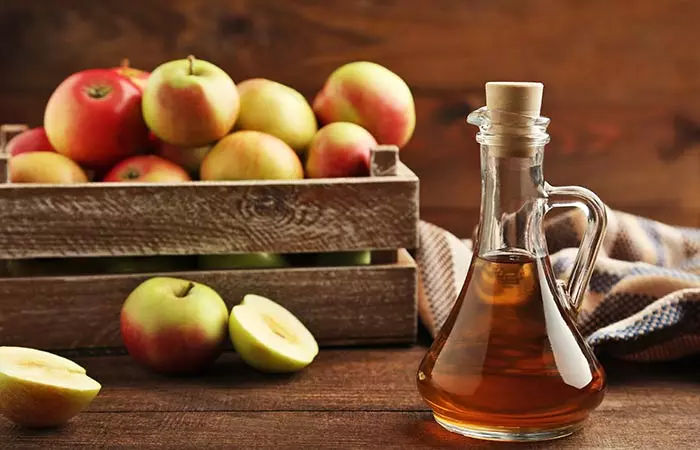
You Will Need
- 1 tablespoon of raw apple cider vinegar (ACV)
- 1 cup of water
- Cotton balls
What You Have To Do
- Add a tablespoon of raw apple cider vinegar to a cup of water.
- Mix well and dip a cotton ball in the solution.
- Gently apply the mixture to the affected skin.
- Discard the used cotton.
- Leave the ACV on for 20-30 minutes and rinse it off.
- Additionally, you can also mix a tablespoon of ACV in a glass of water and drink it daily.
How Often You Should Do This
You may do this once daily.
Why This Works
Apple cider vinegar possesses antibacterial potential against S. aureus. It can help reduce the severity of impetigo symptoms when applied topically and speeds up the healing of the infection when consumed (7).
Caution: Do not give unpasteurized ACV to children as it may lead to food poisoning.
5. Turmeric
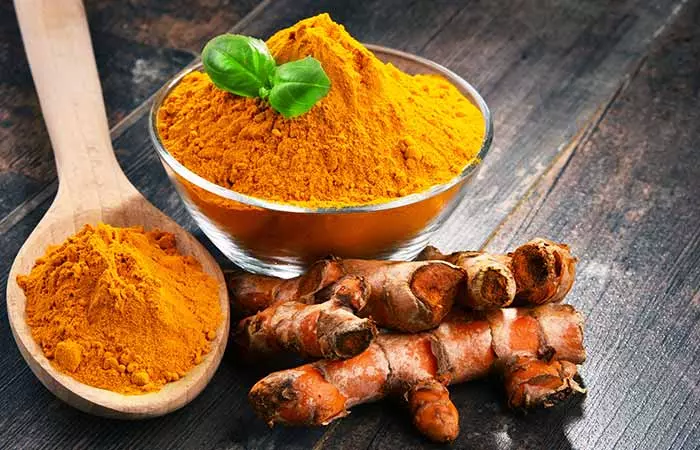
You Will Need
- 1-2 teaspoons of turmeric
- Water (as required)
What You Have To Do
- Mix one to two teaspoons of turmeric powder with water to form a thick paste.
- Apply the turmeric paste to the affected skin.
- Leave it on for 20-30 minutes or until the mixture dries.
- Rinse the paste off your skin using lukewarm water.
- Discard the remaining mixture.
How Often You Should Do This
You may do this once daily.
Why This Works
Curcumin is the main component of turmeric. The antibacterial nature of curcumin is effective against S. aureus (8). The antimicrobial and anti-inflammatory properties of curcumin have been used to treat many skin disorders (9). Hence, turmeric may be beneficial in treating impetigo and its symptoms.
6. Grapefruit Seed Extract

You Will Need
- 2-3 drops of grapefruit seed oil
- 2 tablespoons of water
- Cotton swabs
What You Have To Do
- Add two to three drops of grapefruit seed extract to two tablespoons of water.
- Mix well and dip a cotton swab in it.
- Apply the mixture to the affected skin.
- Leave it on for 20-30 minutes and rinse it off with water.
- Discard the used swabs.
- You can also take grapefruit seed extract supplements after consulting your doctor.
How Often You Should Do This
You can do this 2-3 times daily for faster results.
Why This Works
Grapefruit seed extract is a powerful antibacterial agent that is effective against S. aureus – one of the two bacteria known to cause impetigo (10). It may thus be effective in treating the infection as well as its symptoms.
Caution: Grapefruit seed supplement should not be taken internally by children.
7. Goldenseal
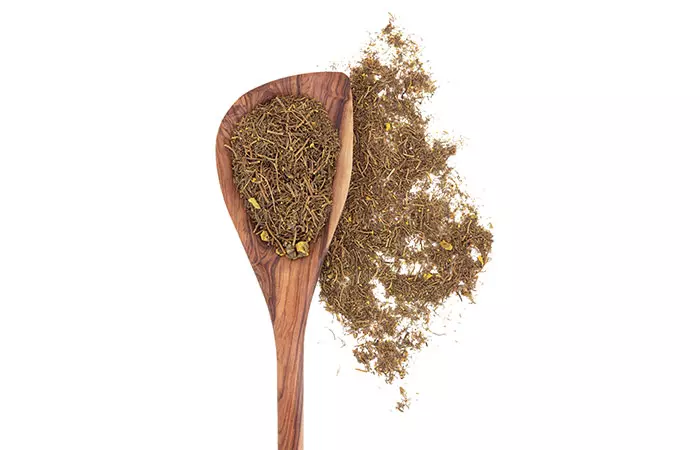
You Will Need
- 1-2 teaspoons of goldenseal powder
- Water (as required)
What You Have To Do
- Mix one to two teaspoons of goldenseal powder with water to form a thick paste.
- Apply the goldenseal paste to the affected skin.
- Leave it on until it dries completely.
- Rinse it off using water.
- Wash your hands thoroughly after contact with the infected skin.
- You can also take goldenseal supplements after consulting your doctor.
How Often You Should Do This
You may do this once daily.
Why This Works
Goldenseal exhibits potent antibacterial activity against S. aureus (11). Hence, it may also be used to speed up the healing of impetigo and its symptoms.
8. Honey
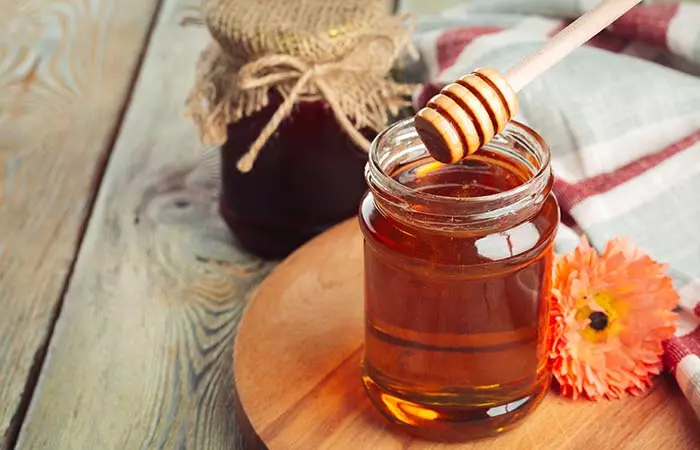
You Will Need
- 1-2 teaspoons of raw honey
- Cotton swabs
What You Have To Do
- Take a little raw honey on a cotton swab.
- Apply it directly to the impetigo sores.
- Discard the swab.
- Allow the honey to sit on your skin for 20-30 minutes.
- Rinse it off with lukewarm water.
How Often You Should Do This
You can do this 1-2 times daily.
Why This Works
Honey is antibacterial
and can help treat S. aureus infection on wounds (12). This suggests that honey may help in the treatment of impetigo symptoms.
9. Aloe Vera
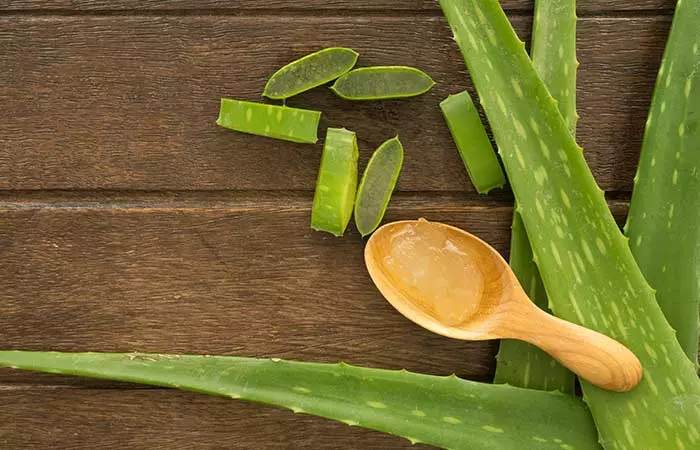
You Will Need
- Freshly extracted aloe gel
- Cotton swabs
What You Have To Do
- Extract the gel from an aloe leaf and blend it well with a fork.
- Take a little aloe gel on a cotton swab.
- Apply it to the infected skin.
- Leave it on for 20-30 minutes and rinse it off.
- Discard the used swabs.
How Often You Should Do This
You can do this 2-3 times daily.
Why This Works
The wound-healing and anti-inflammatory properties of aloe vera could help in quickening the healing of impetigo sores (13), (14).
10. Neem
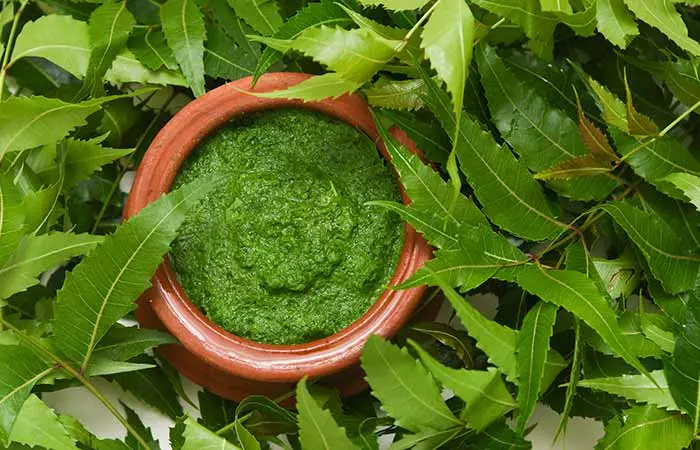
You Will Need
- A handful of neem leaves
- Water (as required)
What You Have To Do
- Take a handful of neem leaves and wash them thoroughly.
- Blend the leaves with some water to form a thick paste.
- Apply the paste to the infected skin.
- Leave it on for 20-30 minutes or until it dries completely.
- Rinse it off your skin.
How Often You Should Do This
You can do this once daily.
Why This Works
Neem can help in the inhibition of S. aureus biofilm formation (15). Hence, it can be an excellent remedy to get rid of the infectious impetigo sores.
11. Chamomile
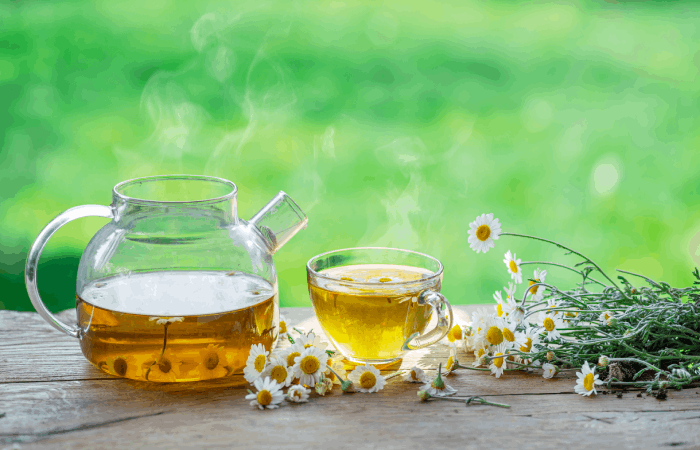
You Will Need
- 5-6 chamomile flowers
- A cup of water
What You Have To Do
- Boil a cup of water and add the flowers to it.
- Keep it aside for 10 minutes.
- Use it as a skin wash or apply it to the affected area.
How Often You Should Do This
You can do this once daily.
Why This Works
Chamomile has shown to act against Staphylococcus aureus in a few instances (16). Some research also suggests that its antimicrobial and anti-inflammatory properties may help combat the infection, accelerate wound healing, and soothe the skin (17). However, further studies are needed to understand the efficacy of chamomile against Staphylococcus aureus.
Note: Although minor cases of impetigo can be effectively treated at home, there are some situations in which antibiotics may be required. Consultation with a healthcare professional is essential if there is no visible improvement after a few days of at-home treatment. In cases where the illness is widespread or recurrent, they may recommend topical or oral antibiotics to help treat it and prevent further complications.
These remedies can do a great job in speeding up recovery from impetigo. However, some people may have recurring bouts of the infection. Hence, you need to take great care and make a few lifestyle changes to prevent this from happening. The following are some tips that can help prevent the recurrence of impetigo.
How To Prevent Impetigo
- Shower daily.
- Wash the infected skin daily using a mild cleanser and water.
- Do not touch the infected sores.
- Wash the clothing and other utensils of an infected person separately.
- Use gloves while applying a topical antibiotic.
- Keep skin injuries clean and covered.
- Wash your hands regularly.
- Keep your nails short.
- Keep the patient isolated until recovery.
Impetigo is a highly contagious skin infection. It is most common in children and infants and causes red sores on the face. While this infection may subside in a few weeks, some natural remedies for impetigo can help accelerate healing. Essential oils like tea tree oil and oregano oil, garlic, coconut oil, apple cider vinegar, and turmeric may help reduce symptoms of this bacterial infection. When applied topically, these natural ingredients exhibit antibacterial properties that act against S. aureus. In addition, washing the infected skin daily, using gloves while applying antibiotics, and keeping your nails trimmed may prevent impetigo. Combine the remedies and tips for a speedy recovery.
While taking preventative steps will significantly decrease the chance of developing impetigo, it is important to identify when symptoms worsen and get medical attention to ensure effective treatment.
When To Seek Help
If you experience any persistent impetigo symptoms like severe pain, spreading sores, or no improvement after treatment, it is important to get medical help. Additionally, you should consult a doctor right away if you experience any symptoms indicating a more serious illness, such as fever, edema, or red streaks appearing from the sores. Early intervention can prevent complications and promote a quicker recovery.
Infographic: Remedies For Impetigo
Click on the infographic below to understand what impetigo is and arm yourself with home remedies to help deal with it better. Addressing wounds immediately and maintaining basic hygiene can go a long way in keeping impetigo under control. We have included a few more tips to help prevent it from spreading further. Read on for more details.
Some thing wrong with infographic shortcode. please verify shortcode syntax
Frequently Asked Questions
How can the risk of developing impetigo be reduced, especially in children who are prone to skin infections?
Dr. Marthe Dika, Board Certified Dermatologist, says, “Children prone to skin infections such as ones with atopic dermatitis should avoid contact with infected individuals, if a household member is infected, they should use separate towels, soap, and avoid sharing personal items.”
Are there any long-term effects or complications that can arise from impetigo?
Dr. Dika says, “Although very rare, one complication of impetigo is acute poststreptococcal glomerulonephritis (APSG) where the kidneys are affected; this is due to a specific strain of streptococcus bacteria. It is important to note that 90-95% of impetigo is caused by Staphylococcus aureus and only 5-10% arise from streptococcus or from the combination of both bacteria.”
How long does it typically take for impetigo to go away with treatment?
Dr. Dika, says, “Treatment recommendation for impetigo is 5–7 days with topical antibiotic +/- oral antibiotic. Once the treatment is initiated, the child can return to school 24–48 hours later or once all the lesions have healed/crusted over (no longer contagious).”
What is the role of hygiene and good skin care in preventing and treating impetigo?
According to Dr. Dika “Hygiene and good skin care is crucial not only in preventing and treating impetigo, but also in preventing recurrence as this infection is highly contagious! The affected area should be cleaned at least twice daily, followed by topical antibiotics. Bacterial decolonization strategies are sometimes recommended with the application of topical antibiotic to the nares (source of the infection) for about 2 weeks +/- topical body regimen with a skin antiseptic solution (eg, chlorhexidine) or diluted bleach baths.”
Can you put hydrocortisone on impetigo?
Yes, but only under medical supervision. Hydrocortisone may help soothe impetigo. However, it may worsen it as well. Hence, consult your doctor before use (18).
Should I put a bandaid on impetigo?
Yes, but only if you tend to pick your sores or have open draining ones. Otherwise, impetigo sores are usually recommended to be left open.
Does Benadryl help impetigo?
Yes. Benadryl is given to children with impetigo to relieve itchiness.
Can you use hydrogen peroxide on impetigo?
Yes, but in its diluted form (1% hydrogen peroxide). The UK National Institute of Clinical Excellence (NICE) recommends cleaning sores with 1% hydrogen peroxide cream due to its antiseptici A substance or chemical agent that slows or prevents the growth of microorganisms and reduces the possibility of infection. properties (19).
How to get rid of impetigo in 24 hours?
Impetigo, being a skin infection, takes time to heal, depending on severity. The remedies mentioned in the article, along with medication, might help speed up the process. However, the infection usually takes days to heal.
Impetigo is a common infectious skin infection that causes red sores. Click on this video to understand how to get the right treatment for this skin issue.
Personal Experience: Source
StyleCraze's articles are interwoven with authentic personal narratives that provide depth and resonance to our content. Below are the sources of the personal accounts referenced in this article.
i. Impetigo – Diagnosis and Natural Treatmenthttps://homeshalom.blogspot.com/2011/06/impetigo-diagnosis-and-natural.html
References
Articles on StyleCraze are backed by verified information from peer-reviewed and academic research papers, reputed organizations, research institutions, and medical associations to ensure accuracy and relevance. Read our editorial policy to learn more.
- “Impetigo” StatPearls, US National Library Of Medicine.
- “Melaleuca alternifolia (Tea Tree) Oil: a Review of Antimicrobial and Other Medicinal Properties” Clinical Microbiology Reviews, US National Library Of Medicine.
- “Effects of oregano, carvacrol and thymol on Staphylococcus aureus and Staphylococcus epidermidis biofilms.” Journal of Medical Microbiology, US National Library Of Medicine.
- “Antibacterial activity of garlic extract on streptomycin-resistant Staphylococcus aureus and Escherichia coli solely and in synergism with streptomycin” Journal Of Natural Science, Biology, and Medicine, US National Library Of Medicine.
- “Immunomodulation and Anti-Inflammatory Effects of Garlic Compounds” Journal Of Immunology, US National Library Of Medicine.
- “Anti-inflammatory, analgesic, and antipyretic activities of virgin coconut oil.” Pharmaceutical Biology, US National Library Of Medicine.
- “Antimicrobial activity of apple cider vinegar against Escherichia coli, Staphylococcus aureus and Candida albicans; downregulating cytokine and microbial protein expression” Scientific Reports, US National Library Of Medicine.
- “Antibacterial Action of Curcumin against Staphylococcus aureus: A Brief Review” Journal Of Tropical Medicine, US National Library Of Medicine.
- “Evidence of curcumin and curcumin analogue effects in skin diseases: A narrative review.” Journal of Cellular Physiology, US National Library Of Medicine.
- “Bactericidal effect of grape seed extract on methicillin-resistant Staphylococcus aureus (MRSA).” Journal of Toxicological Sciences, US National Library Of Medicine.
- “Quorum Quenching and Antimicrobial Activity of Goldenseal (Hydrastis canadensis) against Methicillin-Resistant Staphylococcus aureus (MRSA)” Planta medica, US National Library Of Medicine.
- “Antibacterial activity of honey against strains of Staphylococcus aureus from infected wounds.” Journal of the Royal Society of Medicine, US National Library Of Medicine.
- “Topical Application of Aloe vera Accelerated Wound Healing, Modeling, and Remodeling: An Experimental Study.” Annals of Plastic Surgery. US National Library Of Medicine.
- “Antiinflammatory activity of extracts from Aloe vera gel.” Journal Of Ethnopharmacology, US National Library Of Medicine.
- “Effect of neem (Azadirachta indica A. Juss) leaf extract on resistant Staphylococcus aureus biofilm formation and Schistosoma mansoni worms.” Journal Of Ethnopharmacology, US National Library Of Medicine.
- “Chamomile (Matricaria chamomilla L.): An overview” Pharmacognosy Network Worldwide, US National Library Of Medicine.
- “A systematic review study of therapeutic effects of Matricaria recuitta chamomile (chamomile)” Electron Physician, US National Library Of Medicine.
- “A clinical trial of hydrocortisone/potassium hydroxyquinoline sulphate (’Quinocort’) in the treatment of infected eczema and impetigo in general practice”, US National Library Of Medicine.
- “Treatment of Impetigo with Antiseptics—Replacing Antibiotics (TIARA) trial: a single blind randomised controlled trial in school health clinics within socioeconomically disadvantaged communities in New Zealand”, US National Library Of Medicine.
- “Impetigo” StatPearls, US National Library Of Medicine.
Read full bio of Dr. Priya Gill
- Dr. Marthe N. Dika, MD, is a board-certified dermatologist with her own private practice in Burlington, Wisconsin. She holds a nursing degree from the University of Illinois and a medical degree from the Medical College of Wisconsin. With over 5 years of experience, Dr. Dika provides personalized care to patients of all ages, backgrounds, and skin types. She aims to provide safe, effective, and culturally competent care to her diverse patient population.
 Dr. Marthe N. Dika, MD, is a board-certified dermatologist with her own private practice in Burlington, Wisconsin. She holds a nursing degree from the University of Illinois and a medical degree from the Medical College of Wisconsin. With over 5 years of experience, Dr. Dika provides personalized care to patients of all ages, backgrounds, and skin types. She aims to provide safe, effective, and culturally competent care to her diverse patient population.
Dr. Marthe N. Dika, MD, is a board-certified dermatologist with her own private practice in Burlington, Wisconsin. She holds a nursing degree from the University of Illinois and a medical degree from the Medical College of Wisconsin. With over 5 years of experience, Dr. Dika provides personalized care to patients of all ages, backgrounds, and skin types. She aims to provide safe, effective, and culturally competent care to her diverse patient population.
Read full bio of Shaheen Naser
Read full bio of Arshiya Syeda
Read full bio of Dipti Sharma





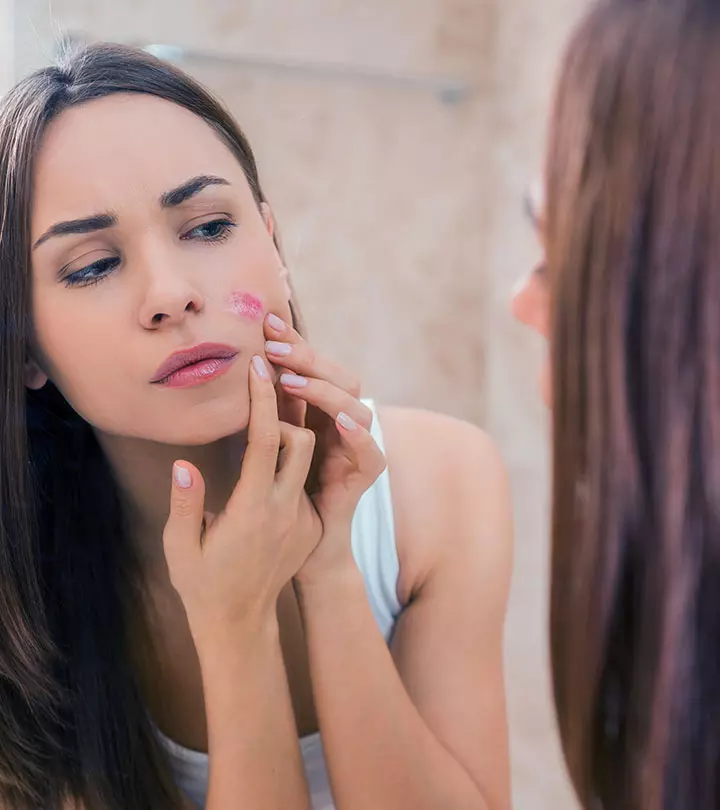
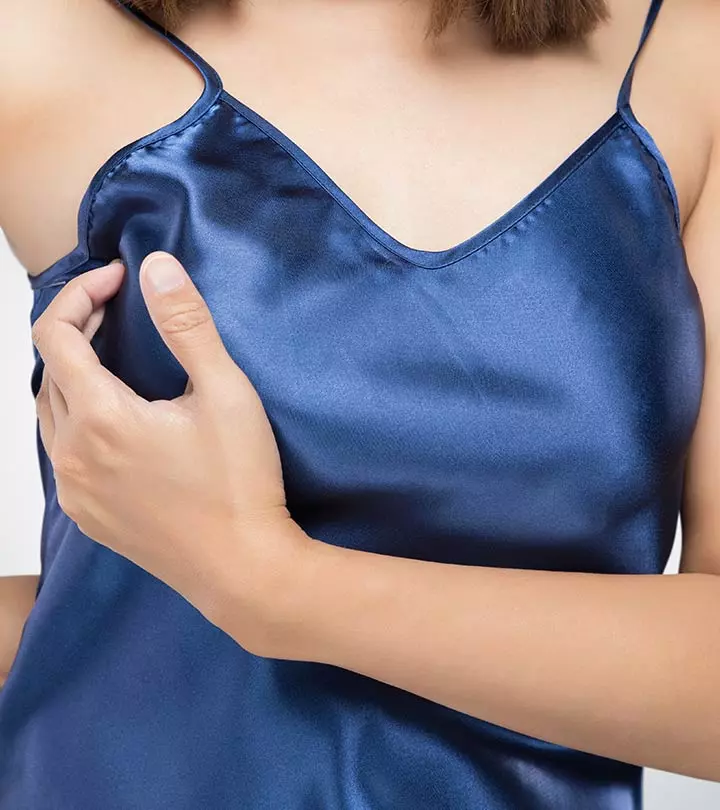
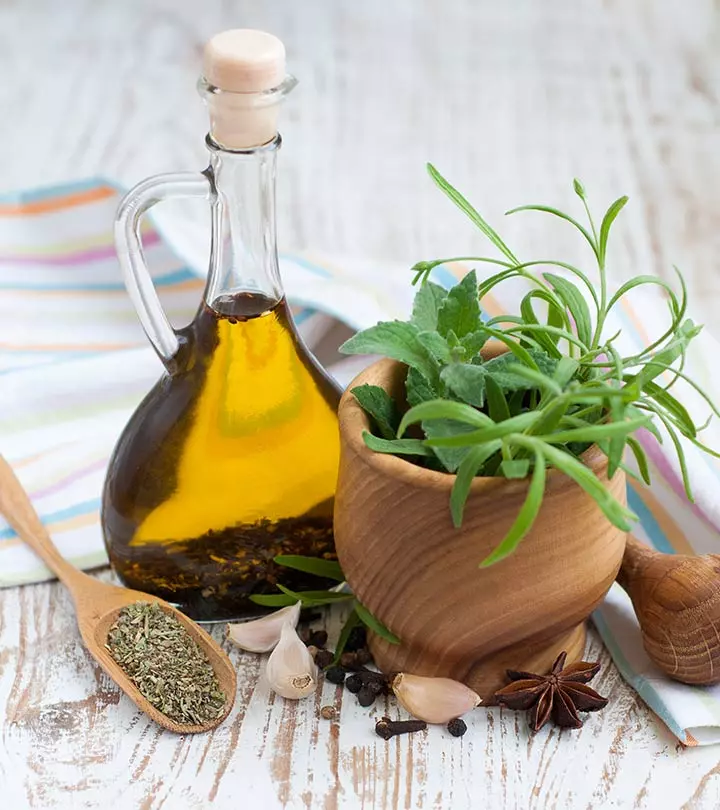
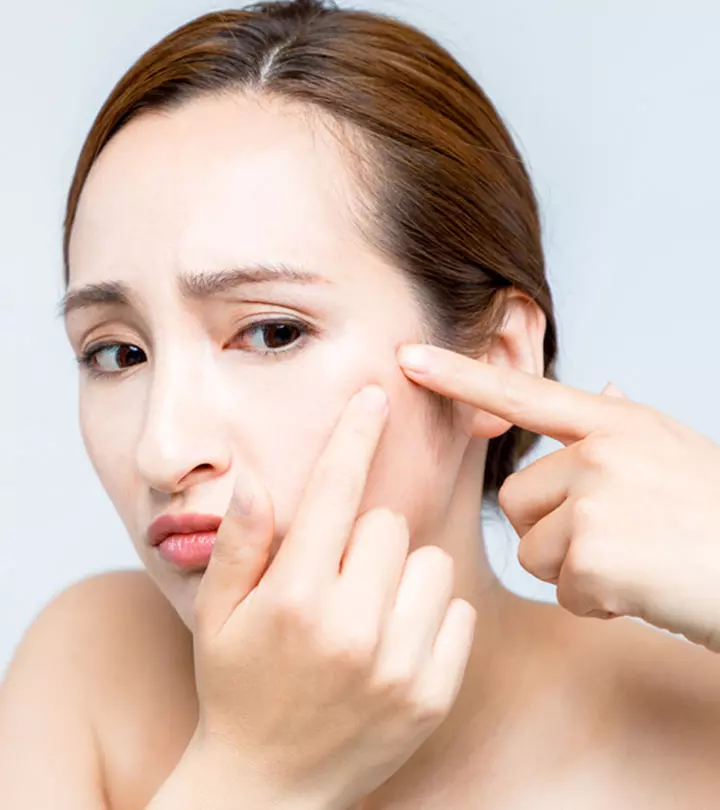


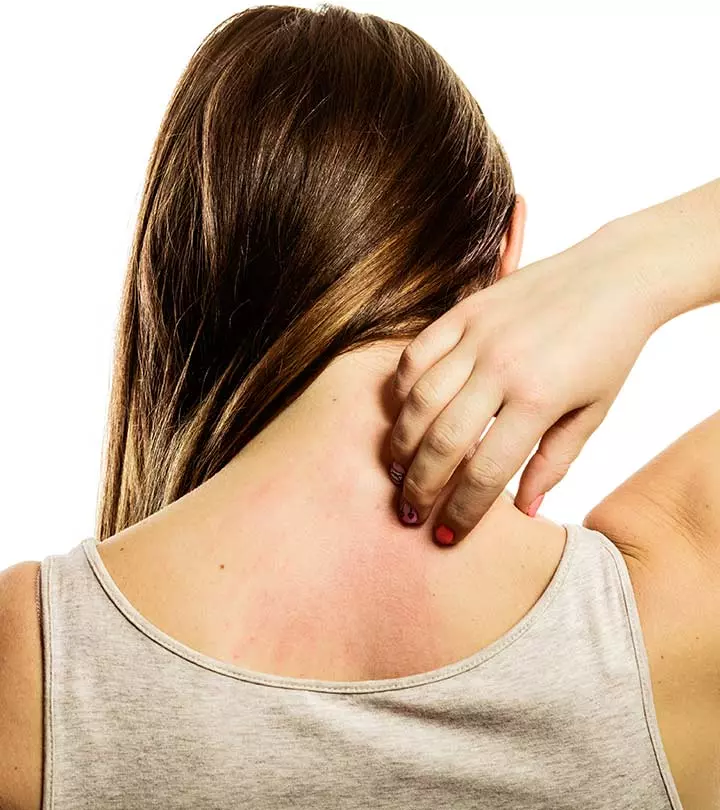
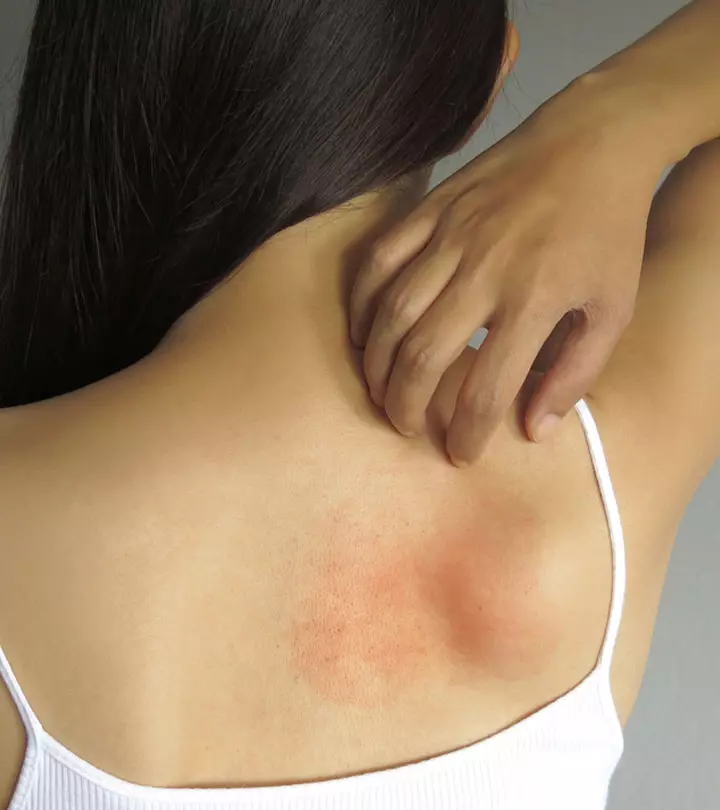

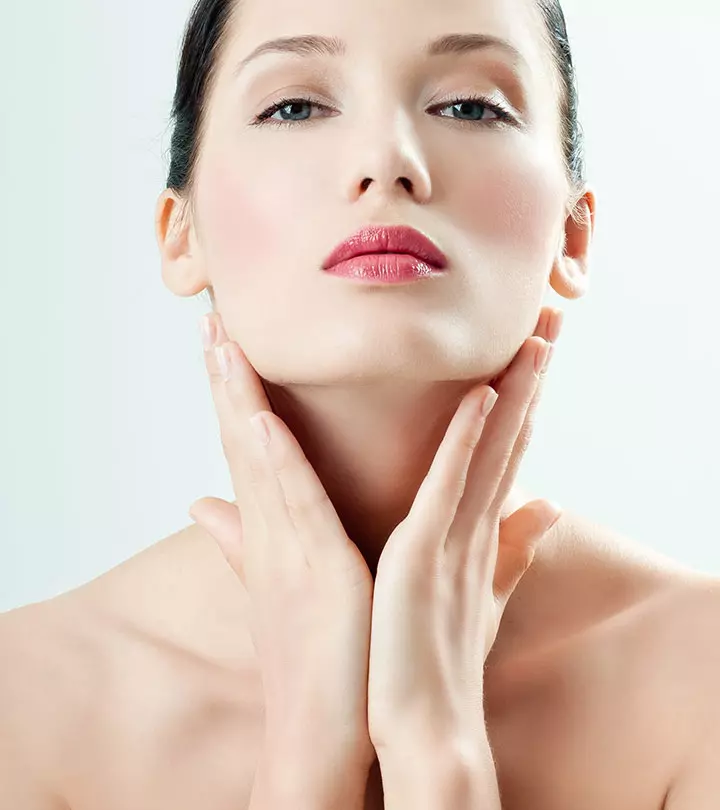


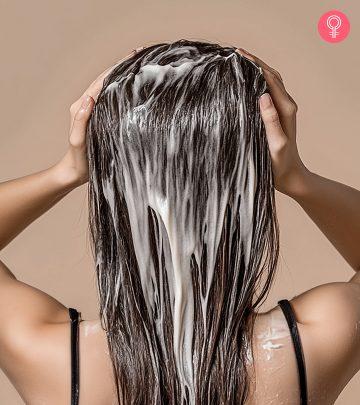

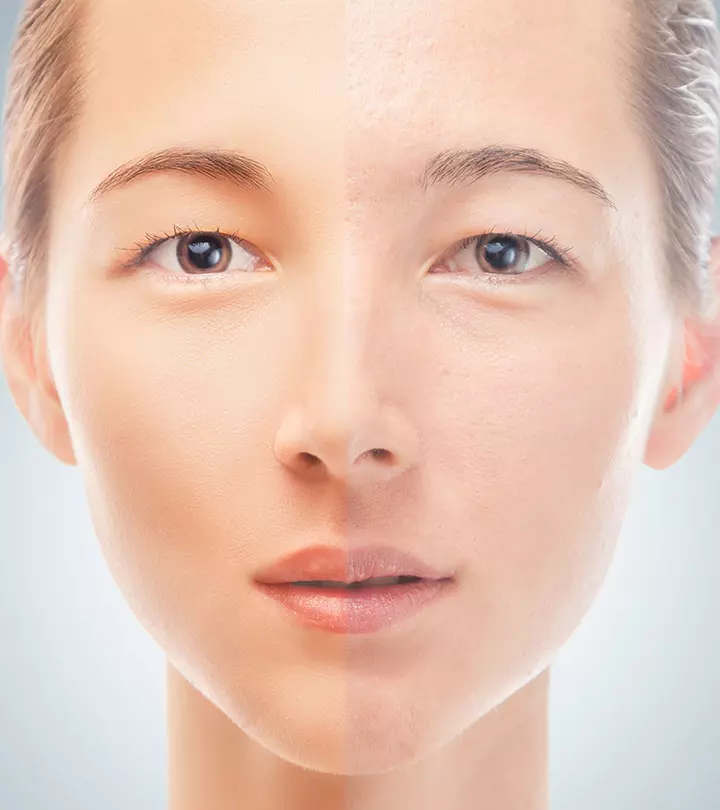



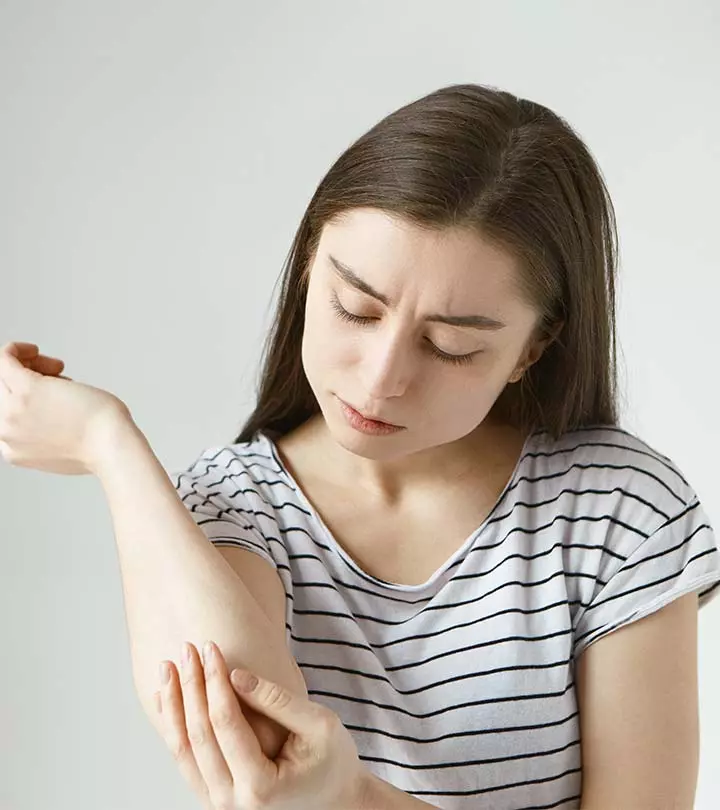


Community Experiences
Join the conversation and become a part of our empowering community! Share your stories, experiences, and insights to connect with other beauty, lifestyle, and health enthusiasts.